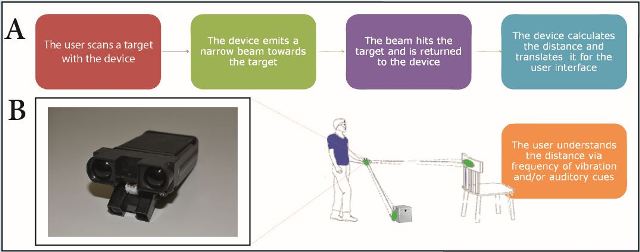Oct 21 2014
Tactile or Auditory Cues Can Enhance the Mobility of Blind Users, According to Study Published in Restorative Neurology
 The EyeCane: (A) A flow chart depicting the use of the device and an illustration of a user. Note the two sensor beams, one pointing directly ahead, and one pointing towards the ground for obstacle detection. (B) Photo of the “EyeCane.”
The EyeCane: (A) A flow chart depicting the use of the device and an illustration of a user. Note the two sensor beams, one pointing directly ahead, and one pointing towards the ground for obstacle detection. (B) Photo of the “EyeCane.”
White Canes provide low-tech assistance to the visually impaired, but some blind people object to their use because they are cumbersome, fail to detect elevated obstacles, or require long training periods to master. Electronic travel aids (ETAs) have the potential to improve navigation for the blind, but early versions had disadvantages that limited widespread adoption. A new ETA, the “EyeCane,” developed by a team of researchers at The Hebrew University of Jerusalem, expands the world of its users, allowing them to better estimate distance, navigate their environment, and avoid obstacles, according to a new study published in Restorative Neurology and Neuroscience.
“The EyeCane was designed to augment, or possibly in the more distant future, replace the traditional White Cane by adding information at greater distances (5 meters) and more angles, and most importantly by eliminating the need for contacts between the cane and the user’s surroundings [which makes its use difficult] in cluttered or indoor environments,” says Amir Amedi, PhD, Associate Professor of Medical Neurobiology at The Israel-Canada Institute for Medical Research, The Hebrew University of Jerusalem.
The EyeCane translates point-distance information into auditory and tactile cues. The device is able to provide the user with distance information simultaneously from two different directions: directly ahead for long distance perception and detection of waist-height obstacles and pointing downward at a 45° angle for ground-level assessment. The user scans a target with the device, the device emits a narrow beam with high spatial resolution toward the target, the beam hits the target and is returned to the device, and the device calculates the distance and translates it for the user interface. The user learns intuitively within a few minutes to decode the distance to the object via sound frequencies and/or vibration amplitudes.
Recent improvements have streamlined the device so its size is 4 x 6 x 12 centimeters with a weight of less than 100 grams. “This enables it to be easily held and pointed at different targets, while increasing battery life,” says Prof. Amedi.
The authors conducted a series of experiments to evaluate the usefulness of the device for both blind and blindfolded sighted individuals. The aim of the first experiment was to see if the device could help in distance estimation. After less than five minutes of training, both blind and blindfolded individuals were able to estimate distance successfully almost 70% of the time, and the success rate surpassed 80% for two of the three blind participants. "It was amazing seeing how this additional distance changed their perception of their environment," notes Shachar Maidenbaum, one of the researchers on Prof. Amedi's team. "One user described it as if her hand was suddenly on the far side of the room, expanding her world.”
A second experiment looked at whether the EyeCane could help individuals navigate an unfamiliar corridor by measuring the number of contacts with the walls. Those using a White Cane made an average of 28.2 contacts with the wall, compared to three contacts with the EyeCane – a statistically significant tenfold reduction. A third experiment demonstrated that the EyeCane also helped users avoid chairs and other naturally occurring obstacles placed randomly in the surroundings.
“One of the key results we show here is that even after less than five minutes of training, participants were able to complete the tasks successfully,” says Prof. Amedi. "This short training requirement is very significant, as it make the device much more user friendly. Every one of our blind users wanted to take the device home with them after the experiment, and felt they could immediately contribute to their everyday lives," adds Maidenbaum.
The Amedi lab is also involved in other projects for helping people who are blind. In another recent publication in Restorative Neurology and Neuroscience they introduced the EyeMusic, which offers much more information, but requires more intensive training. "We see the two technologies as complementar,y" says Prof. Amedi. "You would use the EyeMusic to recognize landmarks or an object and use the EyeCane to get to it safely while avoiding collisions."
A video demonstration of the EyeCane is available at https://www.youtube.com/watch?v=rpbGaPxUKb4. For more information visit the Amedi lab website at http://brain.huji.ac.il where you can also experience an online virtual demonstration of the device.